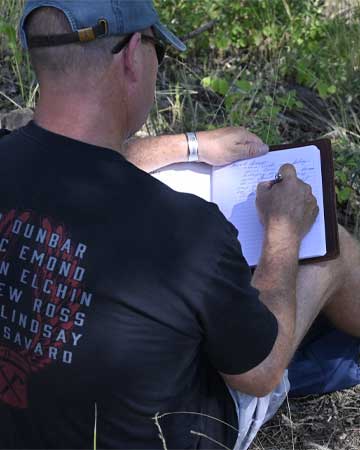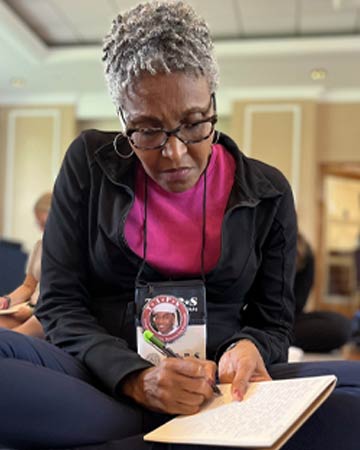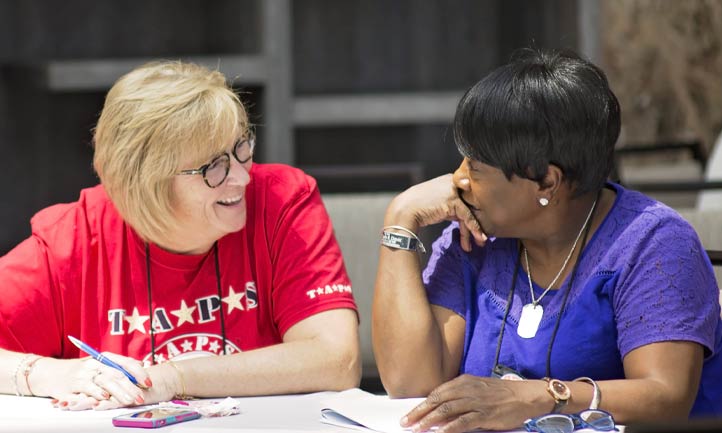You’re Not Crazy — You’re Grieving — Part Four
Author: Alan Wolfelt
Editor's Note
This is part four of a six-part series adapted from Dr. Alan Wolfelt's book, You're Not Crazy — You're Grieving.
Parts one through three were published in the summer 2023, fall 2023, and spring 2024 issues of TAPS Magazine.

Telling Your Stories Helps You Survive
Telling your stories of love and loss helps you survive. The more you allow yourself to tell your stories, the easier it will be to embark on a healthy path toward integrating loss into your life.
Going Backward Before Forward
Since your loss, some of your well-meaning, but misinformed friends and family members have probably been telling you some version of:
- He or she would want you to keep living your life.
- Time heals all wounds.
- Just keep putting one foot in front of the other.
- You need to put the past in the past.
- It’s time to move on.
Not only do these oft-repeated clichés diminish your significant and unique loss, they imply that moving forward — in your life and in time — is what will ease your suffering. In other words, they encourage you to keep on keeping on. But the truth is, paradoxically, in grief, you have to go backward before you can go forward. There is no “moving on” until you first allow your mind and heart to return to the past as often and as long as they need to.
Our cultural misconception about moving forward in grief stems in part from the concept of the “stages of grief,” popularized in 1969 by Elisabeth Kübler-Ross’ landmark text, On Death and Dying. In this important book, Dr. Kübler-Ross listed the five stages of grief that she saw terminally ill patients experience in the face of their own impending deaths: denial, anger, bargaining, depression, and acceptance. However, she never intended for her five stages to be interpreted as a rigid, linear process to be followed by all mourners.
Grief is definitely not orderly, predictable, or stage-like. Instead, it is more of a “getting lost in the woods” experience. And it is recursive. This means that it twists and switches back. It’s shaped more like a random, meandering path than a straight line. When it turns back on itself, it tends to cover the same ground more than once. If you’re angry for a while, for example, you will probably feel your anger return in fits and spurts in the months to come. In fact, every pronounced feeling in grief usually requires repetition to eventually soften and become reconciled.
Grief is not even a “two steps forward, one step backward” kind of dance. Instead, it is often a one step forward, two steps in a circle, one step sideways process. It takes lots of time, patience, and, yes, backward motion before forward motion starts to predominate.

Telling the Story of the Death Itself
Often the first backward-looking part of the story that needs to be explored and revisited in very early grief is the most recent: the death itself.
In previous articles, we reviewed how shock and disbelief are normal and necessary at this time. The death of someone loved often feels unbelievable, even when the death was expected. Our minds and hearts need not only time, but also to reencounter the reality of the death over and over before they can begin to comprehend and absorb what happened. Death is just naturally difficult to fully comprehend.
Initially (and maybe still today), you may have found your thoughts returning to the circumstances, moments, and what-ifs of the death day over and over again. This is normal.
It may be normal, but I know it is also painful. Still, over time, the act of expressing those thoughts outside of yourself begins to soften the blow of the reality as well as the pain. Telling the story to compassionate people you feel safe with — people who are nonjudgmental and good listeners — helps you acknowledge and begin to integrate this difficult reality into your life. Talking in groups about what happened also helps. Writing in a journal about what happened helps, too. Being open and transparent on the outside about what you’re thinking and feeling on the inside always helps, even when it feels scary or painful at first.
So yes, talking about the death helps heal the acute wound. This is counterintuitive to many people. How can talking about a terrible, painful reality possibly make it better? But here’s the thing: You’re thinking about the reality anyway. You probably can’t stop your mind from returning to it. This is a central feature of your inner grief. But sharing your thoughts outside of yourself — in other words, mourning those same thoughts and feelings — relieves some of the inner pressure. It also slowly begins to help you grow to acknowledge what seems, at first, like an impossibility.
Mr. Rogers famously said, “Anything that’s human is mentionable, and anything that is mentionable can be more manageable. When we can talk about our feelings, they become less overwhelming, less upsetting, and less scary.”
Of course, Mr. Rogers was right. So, whenever you find yourself thinking over and over about the facts or circumstances surrounding the death, I encourage you to try expressing those thoughts outside of yourself in some way. In fact, this is a good general principle in grief. Whenever you’re thinking or feeling anything about the death, try sharing it outside of yourself somehow. Expression is what eventually generates forward momentum in integrating your loss and helping you heal.
Actively Exploring Memories
In very early grief — the first days and weeks — memories often come in a chaotic rush. Photos are gathered for the funeral, and people share stories. It’s hard to grasp everything at this time, and many memories can feel especially painful.
If you are still in those really early days, you’re probably struggling with shock and numbness. You might not feel ready to sit down with a photo album. You may not be able to remember all the stories others are sharing with you. If so, this is normal. Give yourself some time to survive the first weeks before focusing on actively exploring memories.
When you do feel ready, make time to encounter your memories in doses. Set aside half an hour here or an hour there to look through photos and videos. At some point, you may find that putting together photo books and memory boxes is a transformative activity. Going through the person’s belongings is another facet of remembering. Writing down anecdotes and biographical information is also an excellent way to explore memories.


But Remembering Hurts!
Yes, it does. Remembering often hurts, especially in the early weeks. It can feel like rubbing salt into the wound. Why on earth would you want to do that? Have you found yourself avoiding photos, belongings, certain people and places, foods, music, and other things precisely so you can avoid the pain of remembering and getting hit by the terrible reality of the death over and over again?
In the very early days and weeks, it’s natural to avoid actively placing yourself in the path of even more memories. Your mind and heart are already struggling to absorb the reality. At the funeral, I hope memories were shared in supportive ways. We know that this is one of the most important functions of ceremony at a time of death. And for some weeks after the funeral, you no doubt had to take care of a lot of paperwork and practical details having to do with the death — plus receive visitors, cards, emails, texts, flowers, food, and more. Conversations with people you haven’t yet spoken to about the death invite you to reencounter the wound of your grief.
So in these early weeks, remembering isn’t really optional. During this challenging period, it’s OK to do (and not do) whatever you need to do to feel safe and comforted as much as possible. But a time will come when actively remembering — gathering, cultivating, and lingering over memories — will provide that backward motion you need to eventually pick up healing momentum and be able to move yourself forward.

Telling the Story of Their Ongoing Love
After the death, you continue to love the person who died. As the dying old man, Morrie, said in Mitch Albom’s bestselling memoir Tuesdays with Morrie, “Death ends a life, not a relationship.”
So as you tell the story of the death and the life of the person who died, don’t forget to also look for opportunities to tell the story of your ongoing love. In fact, your grief is your love now, when the object of your love has gone.
In early grief, finding comfort and sustenance in your continued love for the person who died usually feels like yearning. Perhaps you have been experiencing this. You miss the person so much, and you want them back here with you. It can be a persistent ache. This is painful, but it’s also normal. When it happens, try telling the story of what it feels like. In conversation with others, bring up all the hows, whens, whys, wheres, and ways in which you miss them.
As time passes, your love will remain strong, but the constant yearning will begin to soften. This will be a sign that you are integrating the reality of the death into your continued life. As this happens, you can continue to cherish your love for the person who died by telling the story of their life. Using their name, sharing anecdotes, celebrating special days associated with the person, holding gatherings in their memory, and honoring them on holidays and special occasions are just a few ways to keep telling the story of their life and your ongoing love for them.

Join a TAPS Support Group
TAPS can support you when you are ready to tell your story of love and loss. Find a Care Group in your area to join a community of survivors near you or register for one of our Online Group meetings, organized by relationship, peer group, and cause of death. Connection and compassionate peer support are ready when you are.
Dr. Alan Wolfelt is recognized as one of North America's leading death educators and grief counselors. His books on grief for both caregivers and grieving people — including You're Not Crazy — You're Grieving, from which this article series is adapted — have sold more than a million copies worldwide and are translated into many languages. He is the founder and director of the Center for Loss and Life Transition and a TAPS Advisory Board Member. To learn more, visit centerforloss.com.
Photos: TAPS Archives
